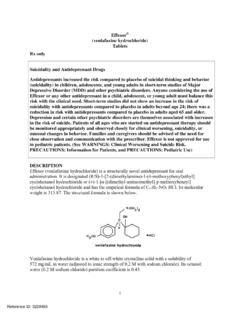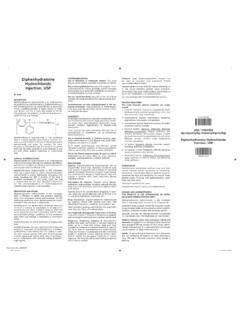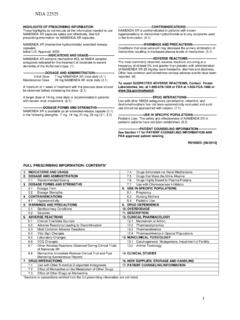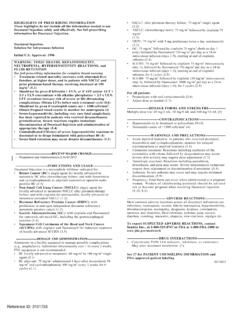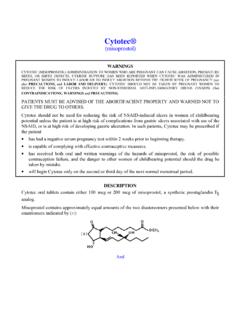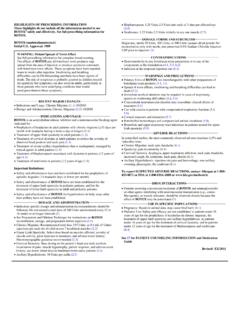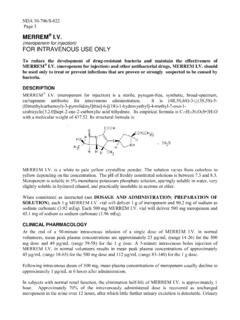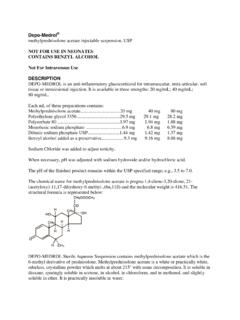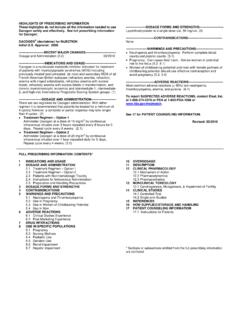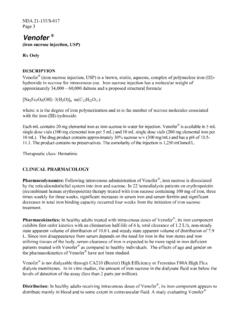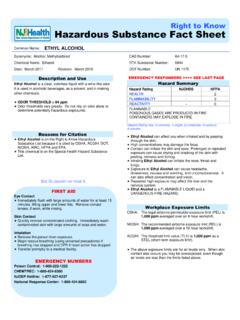Transcription of DITROPAN (oxybutynin chloride) Tablets and Syrup …
1 1 DITROPAN (oxybutynin chloride ) Tablets and Syrup DESCRIPTION Each scored biconvex, engraved blue DITROPAN (oxybutynin chloride ) Tablet contains 5 mg of oxybutynin chloride . Each 5 mL of DITROPAN Syrup contains 5 mg of oxybutynin chloride . Chemically, oxybutynin chloride is d,l (racemic) 4-diethylamino-2-butynyl phenylcyclohexylglycolate hydrochloride. The empirical formula of oxybutynin chloride is C22H31NO3 HCl. The structural formula appears below: Oxybutynin chloride is a white crystalline solid with a molecular weight of It is readily soluble in water and acids, but relatively insoluble in alkalis. DITROPAN Tablets also contain calcium stearate, FD&C Blue #1 Lake, lactose, and microcrystalline cellulose. DITROPAN Syrup also contains citric acid, FD&C Green #3, glycerin, methylparaben, flavor, sodium citrate, sorbitol, sucrose, and water. DITROPAN Tablets and Syrup are for oral administration.
2 Therapeutic Category: Antispasmodic, anticholinergic. CLINICAL PHARMACOLOGY Oxybutynin chloride exerts a direct antispasmodic effect on smooth muscle and inhibits the muscarinic action of acetylcholine on smooth muscle. Oxybutynin chloride exhibits only one fifth of the anticholinergic activity of atropine on the rabbit detrusor muscle, but four to ten times the antispasmodic activity. No blocking effects occur at skeletal neuromuscular junctions or autonomic ganglia (antinicotinic effects). Oxybutynin chloride relaxes bladder smooth muscle. In patients with conditions characterized by involuntary bladder contractions, cystometric studies have demonstrated that oxybutynin chloride increases bladder (vesical) capacity, diminishes the frequency of uninhibited contractions of the detrusor muscle, and delays the initial desire to void. Oxybutynin chloride thus decreases urgency and the frequency of both incontinent episodes and voluntary urination.
3 2 Antimuscarinic activity resides predominately in the R-isomer. A metabolite, desethyloxybutynin, has pharmacological activity similar to that of oxybutynin in in vitro studies. Pharmacokinetics Absorption Following oral administration of DITROPAN , oxybutynin is rapidly absorbed achieving Cmax within an hour, following which plasma concentration decreases with an effective half-life of approximately 2 to 3 hours. The absolute bioavailability of oxybutynin is reported to be about 6% (range to ) for both the tablet and Syrup . Wide interindividual variation in pharmacokinetic parameters is evident following oral administration of oxybutynin. The mean pharmacokinetic parameters for R- and S-oxybutynin are summarized in Table 1. The plasma concentration-time profiles for R- and S-oxybutynin are similar in shape; Figure 1 shows the profile for R-oxybutynin. Table 1 Mean (SD) R- and S-Oxybutynin Pharmacokinetic Parameters Following Three Doses of DITROPAN 5 mg Administered every 8 Hours (n=23) Parameters (units) R-Oxybutynin S-Oxybutynin Cmax (ng/mL) ( ) ( ) Tmax (h) ( ) ( ) AUCt (ng h/mL) ( ) ( ) AUCinf (ng h/mL) ( ) ( ) 4 8 12162024 Time (h)Mean Plasma R-Oxybutynin Concentration (ng/mL)Oxybutynin 5 mg TID Figure 1.
4 Mean R-oxybutynin plasma concentrations following three doses of DITROPAN 5 mg administered every 8 hours for 1 day in 23 healthy adult volunteers 3 DITROPAN steady-state pharmacokinetics were also studied in 23 pediatric patients with detrusor overactivity associated with a neurological condition ( , spina bifida). These pediatric patients were on DITROPAN Tablets (n=11) with total daily dose ranging from mg to 15 mg ( to mg/kg) or DITROPAN Syrup (n=12) with total daily dose ranging from 5 mg to mg ( to mg/kg). Overall, most patients ( ) were taking a total daily DITROPAN dose between 10 mg and 15 mg. Sparse sampling technique was used to obtain serum samples. When all available data are normalized to an equivalent of 5 mg twice daily DITROPAN , the mean pharmacokinetic parameters derived for R- and S-oxybutynin and R- and S-desethyloxybutynin are summarized in Table 2a (for tablet) and Table 2b (for Syrup ).
5 The plasma-time concentration profiles for R- and S-oxybutynin are similar in shape; Figure 2 shows the profile for R-oxybutynin when all available data are normalized to an equivalent of 5 mg twice daily. Table 2a Mean SD R- and S-Oxybutynin and R- and S-Desethyloxybutynin Pharmacokinetic Parameters In Children Aged 5-15 Following Administration of mg to 15 mg Total Daily Dose of DITROPAN Tablets (N=11) All Available Data Normalized to an Equivalent of DITROPAN Tablets 5 mg BID or TID at Steady State R-Oxybutynin S-Oxybutynin R- Desethyloxybutynin S- Desethyloxybutynin Cmax* (ng/mL) Tmax (hr) AUC** ( ) *Reflects Cmax for pooled data **AUC0-end of dosing interval Table 2b Mean SD R- and S-Oxybutynin and R- and S-Desethyloxybutynin Pharmacokinetic Parameters In Children Aged 5-15 Following Administration of 5 mg to mg Total Daily Dose of DITROPAN Syrup (N=12)
6 All Available Data Normalized to an Equivalent of DITROPAN Syrup 5 mg BID or TID at Steady State R-Oxybutynin S-Oxybutynin R- Desethyloxybutynin S- Desethyloxybutynin Cmax* (ng/mL) Tmax (hr) AUC** ( ) *Reflects Cmax for pooled data **AUC0-end of dosing interval 4 024681012024681012 Time (h)Mean R-Oxybutynin Plasma Concentration (ng/mL) DITROPAN Syrup 5 mgDITROPAN IR Tablet 5 mg Figure 2. Mean steady-state ( SD) R-oxybutynin plasma concentrations following administration of total daily DITROPAN dose of 5 mg to 30 mg ( mg/kg to mg/kg) in children 5-15 years of age. Plot represents all available data normalized to the equivalent of DITROPAN 5 mg BID or TID at steady state Food Effects Data in the literature suggests that oxybutynin solution co-administered with food resulted in a slight delay in absorption and an increase in its bioavailability by 25% (n=18).
7 1 Distribution Plasma concentrations of oxybutynin decline biexponentially following intravenous or oral administration. The volume of distribution is 193 L after intravenous administration of 5 mg oxybutynin chloride . Metabolism Oxybutynin is metabolized primarily by the cytochrome P450 enzyme systems, particularly CYP3A4 found mostly in the liver and gut wall. Its metabolic products include phenylcyclohexylglycolic acid, which is pharmacologically inactive, and desethyloxybutynin, which is pharmacologically active. Excretion Oxybutynin is extensively metabolized by the liver, with less than of the administered dose excreted unchanged in the urine. Also, less than of the administered dose is excreted as the metabolite desethyloxybutynin. 5 CLINICAL STUDIES DITROPAN was well tolerated in patients administered the drug in controlled studies of 30 days duration and in uncontrolled studies in which some of the patients received the drug for 2 years.
8 INDICATIONS AND USAGE DITROPAN (oxybutynin chloride ) is indicated for the relief of symptoms of bladder instability associated with voiding in patients with uninhibited neurogenic or reflex neurogenic bladder ( , urgency, frequency, urinary leakage, urge incontinence, dysuria). CONTRAINDICATIONS DITROPAN (oxybutynin chloride ) is contraindicated in patients with urinary retention, gastric retention and other severe decreased gastrointestinal motility conditions, uncontrolled narrow-angle glaucoma and in patients who are at risk for these conditions. DITROPAN is also contraindicated in patients who have demonstrated hypersensitivity to the drug substance or other components of the product. PRECAUTIONS Central Nervous System Effects Oxybutynin is associated with anticholinergic central nervous system (CNS) effects (See ADVERSE REACTIONS). A variety of CNS anticholinergic effects have been reported, including hallucinations, agitation, confusion and somnolence.
9 Patients should be monitored for signs of anticholinergic CNS effects, particularly in the first few months after beginning treatment or increasing the dose. If a patient experiences anticholinergic CNS effects, dose reduction or drug discontinuation should be considered. DITROPAN should be used with caution in patients with preexisting dementia treated with cholinesterase inhibitors due to the risk of aggravation of symptoms. General DITROPAN (oxybutynin chloride ) should be used with caution in the frail elderly, in patients with hepatic or renal impairment, and in patients with myasthenia gravis. DITROPAN may aggravate the symptoms of hyperthyroidism, coronary heart disease, congestive heart failure, cardiac arrhythmias, hiatal hernia, tachycardia, hypertension, myasthenia gravis, and prostatic hypertrophy. 6 Urinary Retention DITROPAN should be administered with caution to patients with clinically significant bladder outflow obstruction because of the risk of urinary retention (see CONTRAINDICATIONS).
10 Gastrointestinal Disorders DITROPAN should be administered with caution to patients with gastrointestinal obstructive disorders because of the risk of gastric retention (see CONTRAINDICATIONS). Administration of DITROPAN to patients with ulcerative colitis may suppress intestinal motility to the point of producing a paralytic ileus and precipitate or aggravate toxic megacolon, a serious complication of the disease. DITROPAN , like other anticholinergic drugs, may decrease gastrointestinal motility and should be used with caution in patients with conditions such as ulcerative colitis, and intestinal atony. DITROPAN should be used with caution in patients who have gastroesophageal reflux and/or who are concurrently taking drugs (such as bisphosphonates) that can cause or exacerbate esophagitis. Information for Patients Patients should be informed that heat prostration (fever and heat stroke due to decreased sweating) can occur when anticholinergics such as oxybutynin chloride are administered in the presence of high environmental temperature.
